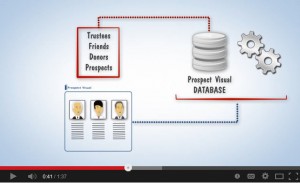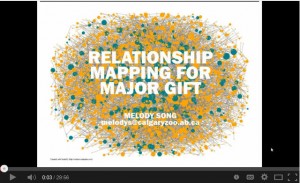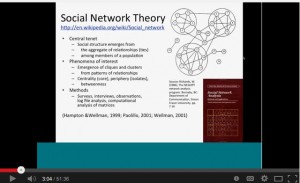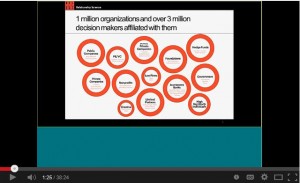 Yes! Relationship mapping is a disruptive technology with the power to change our relationship management process and procedures. But, no worries! Change will probably come slowly.
Yes! Relationship mapping is a disruptive technology with the power to change our relationship management process and procedures. But, no worries! Change will probably come slowly.
Disruptive technology makes for great headlines, but most technology slips into our life a little bit at a time. We don’t have small computers; we have smart phones. We don’t have a wired house; we have a phone app to adjust our heating and air conditioning system.
Mapping out the connections between our prospects gives us linkage. This is one of the three pillars of a good prospect: Linkage – Ability – Inclination.
So far the technology has worked best in for-profit situations like the financial management industry. But companies like Prospect Visual and Relationship Science are nimbly adjusting their products to provide value for the nonprofit industry.
How might relationship mapping be disruptive?
Right now, higher education has the biggest opportunity to make relationship mapping a disruptive – and competitive – edge to their fundraising. Why? Because they have a natural prospect pool (their alumni) and an avalanche of data on those prospects.
Data points include degree, club membership, event attendance, birth date, and so much more! And they have year upon year of graduating (and non-graduating) students. All of this means that higher education can deeply analyze relationships between their alumni.
It’s disruptive because that university might discover that the way they have typically assigned prospects to gift officers is counter-productive. Most organizations segment the prospect pool by geography and/or school of study. It all made sense because that was the data that was available to use for segmenting. Throw in relationship maps and you now have a new perspective.
For example, if my prospect is densely connected – has the most connections to other people – why wouldn’t I assign the densely connected prospect *and his connections* to the same gift officer regardless of where they live? That is a game changer!
And that’s just a shallow view. Deeper analysis will likely reveal other more meaningful ways to assign prospects to gift officers based on how they are connected and other data modeling.
But I work for a smaller institution. What about me?
Huge institutions are always on the trending edge. And while it’s exciting to hear about, it’s not terribly applicable to the majority of nonprofit organizations. Or is it?
Recently I have had some thrilling moments using the relationship mapping tool offered by Prospect Visual. We’ve been working with a client who is trying hard to get a fundraising initiative off the ground with corporations and foundations. But it’s new so everyone is a bit unsure about where to start and how to make the cold calls. And then staff turned over. A familiar scenario to most of us!
So when they asked me to do some deeper research on their top prospects I really wanted to give them confidence to approach the prospect. I really wanted my research to persuade them to pick up the telephone. But how? By giving them a name of one of their own that is connected to the prospect, of course.
And I did it!! It didn’t work for every prospect and sometimes the connections seemed tenuous, but I found connections I would never have found otherwise. I delivered an obvious, and much more comfortable, first phone call to make – to one of their own.
Not so very long ago, finding connections was limited in scope and extremely tedious. Now, using Prospect Visual, I can identify possible connections and then dig a little deeper to verify them. It’s as transformative to my work in research as the microwave was to home cooking!
What Should Every Nonprofit Do Right Now?
Maybe you don’t have a prospect researcher on staff, are not in a position to purchase a subscription to a product like Prospect Visual, or don’t have the resources to outsource research. Even that should not stop you from getting on board the data wagon. And make no mistake – success in the game of life has always been about information!
Eventually relationship mapping and other data tools will become incorporated into your donor database or in some other way made easily accessible. When that happens, you need to be ready. Here’s what you can do:
- Collect Data. It’s not an option anymore. You should be collecting all of the data your prospects give you. Go way beyond contact and gift information: directorships, education, work history, event attendance, phone calls, mailings, conversations. Whatever they tell you, add it!
- Invest in Data. You should value and invest in data management. Hire smart, talented people. Keep them happy so they stay with you. Listen when they talk about consistency and longevity in recording and maintaining information.
- Create a Data Culture. Maybe you’ll think I’m getting a little extreme here, but why not allow the love of data to color the glasses you view your human resources through? From board members to janitors, hire people whose behaviors reflect decision-making based on data.
Of course it’s all about the Relationship!
Relationship management, prospect management, or moves management – whatever we call our system of engaging and staying in touch with our supporters and prospective supporters – starts with a connection.
Relationship mapping can give us a whole new perspective on how we are connected to our prospects and donors. First we climbed a tree to get a good view -we used a database to view our donors- and now suddenly we are looking down from a helicopter -with relationship mapping.
At first it can be a bit disorienting to be able to see so many connections, especially because false connections are mixed in with true connections. But best practices are being developed and tested.
If you are interested to learn more about how relationship mapping can add new perspective to your prospect management efforts, contact Aspire Research Group, sign-up for the relationship mapping work group, or check out the resources and videos below.
Other Resources You Might Like
- Relationship Fundraising needs a brand re-fresh. How about Engagement Fundraising?
- Top Secret! How to Bulk up your Prospect Pool
- Defining an Action in Moves Management
- Mastering Moves Management: 3 Key Pieces



